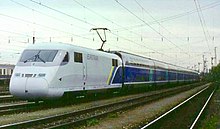
The TGV is France's intercity high-speed rail service, operated mainly by SNCF. SNCF worked on a high-speed rail network from 1966 to 1974 and presented the project to President Georges Pompidou who approved it. Originally designed as turbotrains to be powered by gas turbines, TGV prototypes evolved into electric trains with the 1973 oil crisis. In 1976 the SNCF ordered 87 high-speed trains from Alstom. Following the inaugural service between Paris and Lyon in 1981 on the LGV Sud-Est, the network, centered on Paris, has expanded to connect major cities across France and in neighbouring countries on a combination of high-speed and conventional lines. The TGV network in France carries about 110 million passengers a year.

The TGV Atlantique (TGV-A) is a class of high-speed trains used in France by SNCF; they were built by Alstom between 1988 and 1992, and were the second generation of TGV trains, following on from the TGV Sud-Est trainsets. The trains were named after the Ligne à Grande Vitesse Atlantique that they were originally built for.

The SNCF TGV Réseau (TGV-R) is a TGV train built by Alstom between 1992 and 1996 for SNCF, the French national railway for use on high-speed TGV services. The Réseau trainsets are based on the earlier TGV Atlantique. The first Réseau sets entered service in 1993.
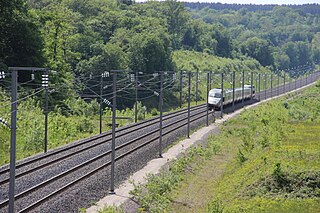
The Ligne à Grande Vitesse Est européenne, typically shortened to LGV Est, is a French high-speed rail line that connects Vaires-sur-Marne and Vendenheim. The line halved the travel time between Paris and Strasbourg and provides fast services between Paris and the principal cities of Eastern France as well as Luxembourg and Germany. The LGV Est is a segment of the Main Line for Europe project to connect Paris with Budapest with high-speed rail service.
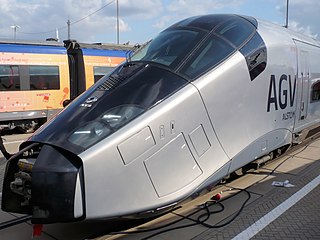
The AGV is a standard gauge, high-speed, electric multiple-unit train designed and built by Alstom.

The SNCF TGV Sud-Est was a French high speed TGV train built by Alstom and Francorail-MTE and operated by SNCF, the French national railway company. A total of 111 trainsets were built between 1978 and 1988 for the first TGV service in France between Paris and Lyon which opened in 1981. The trainsets were semi-permanently coupled, consisting of two power cars (locomotives) and eight articulated passenger carriages, ten in the case of the tri-voltage sets. The trains were named after the Ligne à Grande Vitesse Sud-Est that they first operated on. They were also referred to as TGV-PSE, an abbreviation of Paris Sud-Est.

The TGV POS is a TGV train built by French manufacturer Alstom which is operated by the French national rail company, the SNCF, in France's high-speed rail lines. It was originally ordered by the SNCF for use on the LGV Est, which was put into service in 2007. POS is an abbreviation of Paris-Ostfrankreich-Süddeutschland the route of the LGV Est.
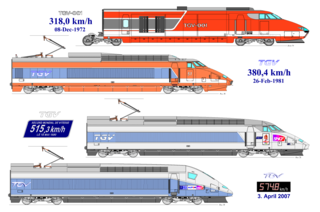
The TGV holds a series of land speed records for rail vehicles achieved by SNCF, the French national railway, and its industrial partners. The high-speed trials are intended to expand the limits of high-speed rail technology, increasing speed and comfort without compromising safety.

The ICE 2 is the second series of German high-speed trains and one of six in the Intercity-Express family since 1995. The ICE 2 (half-) trains are even closer to a conventional push–pull train than the ICE 1, because each train consists of only one locomotive, six passenger cars and a cab car. The maximum speed is 280 km/h (175 mph), but this is limited to 250 km/h (155 mph) when the cab car is leading the train and even further down to 160 km/h (100 mph) when two units are coupled at the powerheads due to the forces on the overhead line by their respective pantographs.

Gare de Valence TGV is a railway station in Valence, France which offers regular TGV services. The station, located in eastern Valence (Alixan), is about ten kilometres north-east from the town centre, allowing through trains to pass at full speed. With its opening in 2001, the station has considerably shortened travel times for travellers throughout eastern France.

TGV Lyria is the brand name used for TGV railway lines connecting France and Switzerland. Lyria is also a corporation that runs the service using the staff of the SNCF in France and Swiss Federal Railways (SBB CFF FFS) in Switzerland – the staff consists of one French and one Swiss train manager on the whole journey.

The SNCF Class Z 22500, also known as the MI 2N "Eole" or MI 2N is a double-deck, dual-voltage electric multiple unit trainset that is operated on line E of the Réseau Express Régional (RER), a hybrid suburban commuter and rapid transit system serving Paris and its Île-de-France suburbs. The trains are SNCFs version of the MI 2N and looks similar to the other variant, the MI 2N "Altéo" trains but each features different motorization and interior layout.

The KTX-I, also known as the TGV-K or Korail Class 100000, is a South Korean high speed train class based on the French TGV Réseau. The 20-car formation of the trainsets without restaurant car is optimized for high capacity. The 46 trainsets were built partly in France and partly in South Korea in the framework of a technology transfer agreement, which was the basis for further domestic high-speed train development in South Korea.

France has a large network of high-speed rail lines. As of June 2021, the French high-speed rail network comprises 2,800 km (1,740 mi) of tracks, making it one of the largest in Europe and the world. As of early 2023, new lines are being constructed or planned. The first French high-speed railway, the LGV Sud-Est, linking the suburbs of Paris and Lyon, opened in 1981 and was at that time the only high-speed rail line in Europe.
Eurotrain was a joint venture formed by Siemens and GEC-Alstom to market high-speed rail technology in Asia. In 1997 it was one of two competitors to supply the core system of Taiwan High Speed Rail (THSR), and it was awarded the status of preferred bidder by concessionaire THSRC. Eurotrain assembled a demonstration train, but later THSRC decided to award the contract to a rival consortium, leading to a legal battle ending in damage payments for Eurotrain in 2004.

The Contournement Nîmes – Montpellier, also known as the LGV Nîmes–Montpellier, is a French high-speed railway line, bypassing the cities of Nîmes and Montpellier in Southern France. It has the distinction of being the first ligne à grande vitesse to be intentionally built for mixed passenger and freight traffic.
Ouigo is a French low-cost service range of both conventional and high-speed trains. The literal translation of Ouigo from French to English is "yes go"; the name is also a play on words with the English homonym "we go." It is composed of two different services: Ouigo Grande Vitesse, which is a brand of SNCF operating high-speed trains; and Ouigo Vitesse Classique, a brand under which Oslo, a subsidiary of SNCF, operates conventional speed trains.
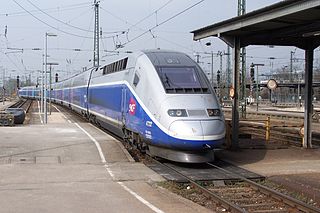
Avelia Euroduplex, more commonly known as just Euroduplex or TGV 2N2 in France, is a high-speed double-decker train manufactured by Alstom. It is primarily operated by the French national railway company SNCF, and also in operation with the Moroccan national railway company ONCF. It is the 3rd generation of the TGV Duplex.

The TGV M is a high-speed passenger train designed and produced by Alstom. It has a broadly similar design to the TGV Duplex sets, with bi-level carriages and a push–pull configuration with a power car on either end. However, it is more energy efficient and provides lower operating costs.





